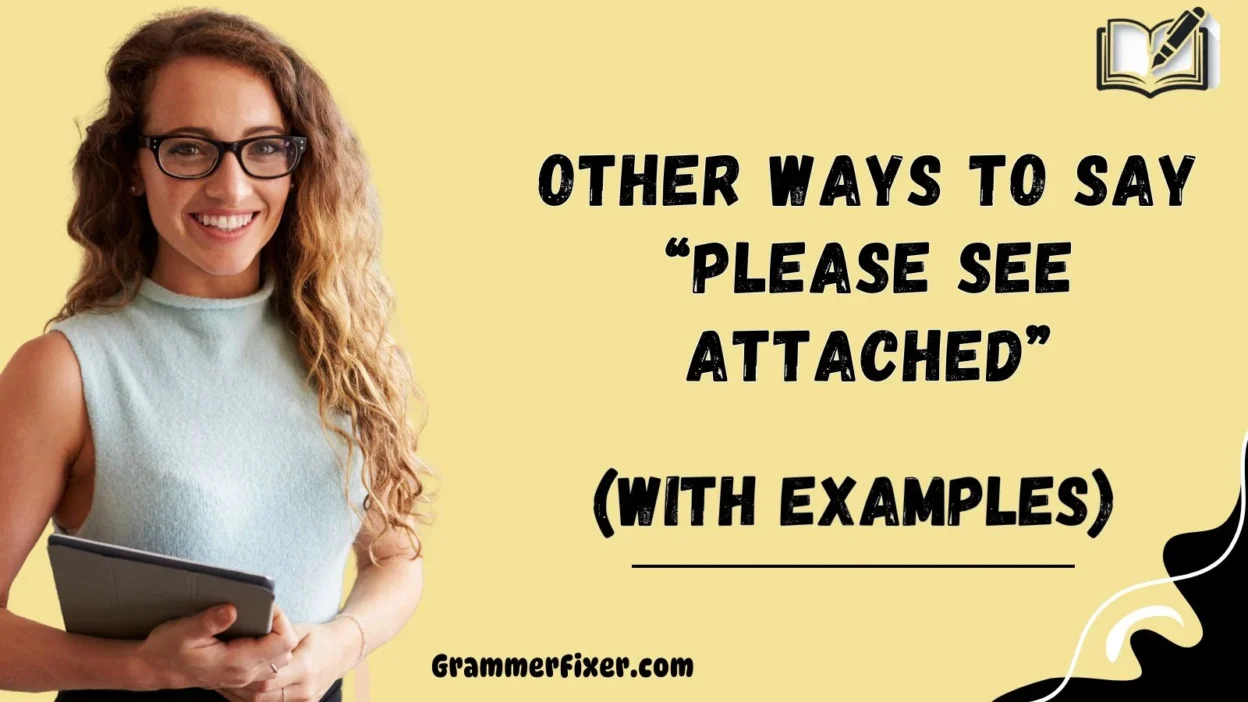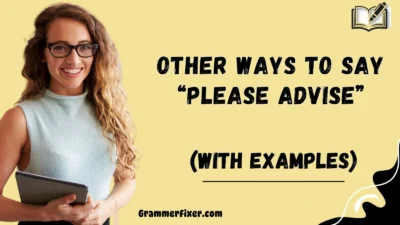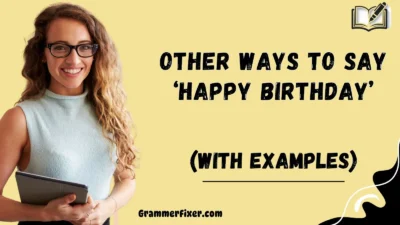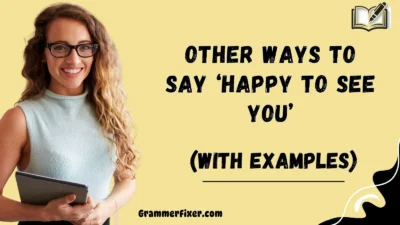Finding the right words in professional communication is more than just a matter of style—it’s about showing care, respect, and thoughtfulness for the person reading your message. The phrase “Please See Attached” is common in emails, but it can sometimes feel flat, impersonal, or even rushed. Choosing a more empathetic, conversational alternative can help your email feel warmer, clearer, and more professional.
Below, you’ll find 30 different ways to say “Please See Attached”, complete with their meanings, explanations, scenarios, best use, and tone—so you can pick the one that best matches your message, relationship, and context.
What Does “Please See Attached” Mean?
The phrase “Please See Attached” is a short instruction used in emails to draw attention to a file or document included with the message. It signals that the recipient should review, open, or use the attached material.
When to Use “Please See Attached”?
You use “Please See Attached” when you’re sharing documents, images, reports, proposals, or files with someone via email. It works well in formal, professional, and transactional communication, especially in business or academic settings.
Is It Professional/Polite to Say “Please See Attached”?
Yes—it is professional and polite, but it can sometimes come across as too abrupt or generic. In emails where you want to build rapport, show thoughtfulness, or create engagement, softer alternatives may be more effective.
Pros or Cons of Using “Please See Attached”
Pros:
- Clear and concise.
- Universally understood.
- Professional in tone.
Cons:
- Can sound cold or impersonal.
- Overused in business correspondence.
- May feel rushed, especially without context.
1. Please Find Attached
Meaning: A classic, formal way of directing someone to an attachment.
Detailed Explanation: Polite and professional, often used in business letters and emails.
Scenario Example: “Please find attached the quarterly report for your review.”
Best Use: Formal correspondence with clients, managers, or officials.
Worst Use: In casual team chats or friendly communication—it may sound stiff and overly formal.
Tone: Respectful, professional, traditional.
2. Kindly Find Attached
Meaning: A softer variation that adds politeness.
Detailed Explanation: Common in international English, especially South Asian business communication.
Scenario Example: “Kindly find attached the signed agreement.”
Best Use: When you want to emphasize politeness and courtesy.
Worst Use: With native English speakers in informal or modern settings—it may feel outdated or unnecessarily formal.
Tone: Gentle, formal, considerate.
3. Attached Herewith
Meaning: Old-fashioned but still recognized in formal/legal settings.
Detailed Explanation: Suggests the document is included with the email, typically used in legal or government contexts.
Scenario Example: “Attached herewith is the invoice for your payment.”
Best Use: Legal documents, contracts, or official government communication.
Worst Use: Everyday business emails or casual team correspondence—it feels archaic and unnecessarily stiff.
Tone: Very formal, traditional, legalistic.
4. Attached Is
Meaning: A direct way of pointing out the attached file.
Detailed Explanation: Keeps the sentence short and professional without sounding too stiff.
Scenario Example: “Attached is the updated project timeline for your review.”
Best Use: Internal business communication when efficiency matters.
Worst Use: With external clients where warmth and professionalism are expected—may feel too blunt.
Tone: Direct, clear, neutral.
5. Here Is the Document You Requested
Meaning: Highlights that the file was specifically requested.
Detailed Explanation: Shows attentiveness and responsiveness by acknowledging the recipient’s earlier request.
Scenario Example: “Here is the document you requested in yesterday’s meeting.”
Best Use: When responding to a client or colleague’s request.
Worst Use: Sending files that weren’t requested—can cause confusion.
Tone: Helpful, responsive, respectful.
6. Please Review the Attached
Meaning: Encourages the recipient not just to notice but to review the file.
Detailed Explanation: Useful when you’re expecting feedback, corrections, or approval.
Scenario Example: “Please review the attached proposal and share your thoughts.”
Best Use: Collaboration and review-focused communication.
Worst Use: When simply sending a file for information only—may pressure the recipient unnecessarily.
Tone: Encouraging, collaborative, purposeful.
7. For Your Reference, See Attached
Meaning: Suggests the file is provided as helpful background or supporting material.
Detailed Explanation: Softer and more thoughtful, showing you are being considerate of the recipient’s needs.
Scenario Example: “For your reference, see attached the updated brand guidelines.”
Best Use: When providing supportive documentation or optional reading.
Worst Use: When the file is mandatory to act on—it may downplay urgency.
Tone: Considerate, informative, respectful.
8. I’ve Included the File Below
Meaning: A casual, modern way to introduce an attachment.
Detailed Explanation: Works well in semi-formal communication, creating a friendly tone without losing professionalism.
Scenario Example: “I’ve included the file below with the updated figures.”
Best Use: With colleagues, collaborators, or familiar clients.
Worst Use: Strictly formal communication—it may sound too casual.
Tone: Friendly, conversational, approachable.
9. Please See the Attached Document for Details
Meaning: A polite phrase directing attention to the file for further information.
Detailed Explanation: Makes clear that the document contains important details the reader should consult.
Scenario Example: “Please see the attached document for details of the policy update.”
Best Use: When the file explains something too lengthy to include in the email body.
Worst Use: With very small, simple attachments—it may overcomplicate the tone.
Tone: Professional, detailed, formal.
10. Enclosed Is
Meaning: A traditional phrase, originally used for letters, still seen in formal communication.
Detailed Explanation: Works in both printed correspondence and email, though somewhat formal.
Scenario Example: “Enclosed is the signed contract for your records.”
Best Use: Formal letters, legal, financial, or academic correspondence.
Worst Use: Internal company emails or casual exchanges—it may sound outdated.
Tone: Formal, respectful, traditional.
11. I Am Sharing the Requested File
Meaning: Positions the act of sending the file as an intentional, helpful gesture.
Detailed Explanation: Adds warmth by framing the attachment as something you are actively sharing.
Scenario Example: “I am sharing the requested file with today’s updated data.”
Best Use: When you want to sound friendly yet professional.
Worst Use: High-stakes or legal contexts—may sound too casual.
Tone: Warm, intentional, cooperative.
12. The Document Is Attached for Your Review
Meaning: Clarifies both the presence and the purpose of the file.
Detailed Explanation: Explicitly connects the attachment with the reader’s responsibility.
Scenario Example: “The document is attached for your review and approval.”
Best Use: Feedback requests, project approvals, client proposals.
Worst Use: Casual team updates—it may feel too formal.
Tone: Professional, clear, direct.
13. Please Have a Look at the Attached File
Meaning: Invites the recipient to check the attachment.
Detailed Explanation: Polite but conversational, making the request feel lighter.
Scenario Example: “Please have a look at the attached file and let me know your feedback.”
Best Use: Semi-formal or casual workplace communication.
Worst Use: Strictly formal/legal contexts—it may feel too casual.
Tone: Friendly, courteous, approachable.
14. I’ve Attached the Report for Your Review
Meaning: Directly states the attachment while explaining why it’s included.
Detailed Explanation: Balances professionalism with approachability.
Scenario Example: “I’ve attached the report for your review before tomorrow’s meeting.”
Best Use: Team settings, project management, or client deliverables.
Worst Use: When sending highly formal or legal documents—it may be too relaxed.
Tone: Clear, practical, semi-formal.
15. For Your Convenience, the File Is Attached
Meaning: Emphasizes helpfulness and consideration.
Detailed Explanation: Shows you’re mindful of making things easy for the recipient.
Scenario Example: “For your convenience, the file is attached with the revised schedule.”
Best Use: Client communication or customer service contexts.
Worst Use: When the file is mandatory—“convenience” may downplay its importance.
Tone: Considerate, client-focused, polite.
16. Please Refer to the Attached
Meaning: Directs the reader to consult the file for important information.
Detailed Explanation: A clear, formal phrase often used in professional emails where the file is essential.
Scenario Example: “Please refer to the attached budget breakdown for Q3.”
Best Use: Business, finance, and academic correspondence requiring precision.
Worst Use: Casual team messages—it can sound stiff and overly formal.
Tone: Professional, instructional, clear.
17. Attached for Your Review and Action
Meaning: Indicates that the recipient needs to both review and act on the file.
Detailed Explanation: Stronger than “see attached,” this phrase conveys urgency and expectation.
Scenario Example: “Attached for your review and action is the revised contract draft.”
Best Use: Urgent or high-priority matters.
Worst Use: Informal updates where no action is required—it may overwhelm the reader.
Tone: Assertive, directive, professional.
18. Here’s the File You Asked For
Meaning: Friendly acknowledgment that you’re fulfilling a request.
Detailed Explanation: Personal and conversational, great for building rapport.
Scenario Example: “Here’s the file you asked for during yesterday’s meeting.”
Best Use: Casual communication with colleagues or friendly clients.
Worst Use: Legal, academic, or high-stakes professional communication.
Tone: Warm, conversational, approachable.
19. Attached Are the Records You Requested
Meaning: Confirms that the specific records have been included.
Detailed Explanation: Shows precision by naming what’s attached.
Scenario Example: “Attached are the records you requested for the audit.”
Best Use: When accuracy and confirmation are important (e.g., finance, HR, auditing).
Worst Use: Casual team discussions—it may feel too formal.
Tone: Specific, formal, clear.
20. I’m Sending You the Requested Information
Meaning: Highlights the action of sending while confirming you’ve addressed their need.
Detailed Explanation: Shows responsiveness and attentiveness to the recipient.
Scenario Example: “I’m sending you the requested information on our updated pricing packages.”
Best Use: Client service, customer support, or collaborative project communication.
Worst Use: Strictly legal or highly formal correspondence.
Tone: Helpful, cooperative, respectful.
21. Please Check the Attached File
Meaning: Requests that the recipient review or confirm the file.
Detailed Explanation: Direct and to the point while remaining polite.
Scenario Example: “Please check the attached file and confirm receipt.”
Best Use: When follow-up or confirmation is required.
Worst Use: Casual sharing—it can sound a bit demanding.
Tone: Polite, firm, straightforward.
22. Find the Attachment Below
Meaning: Indicates the file is included directly under the message.
Detailed Explanation: Simple and clear, often used when attachments are visually obvious.
Scenario Example: “Find the attachment below with the slides from today’s presentation.”
Best Use: Semi-formal communication where brevity is important.
Worst Use: Legal or academic documents—it may sound too casual.
Tone: Direct, neutral, semi-formal.
23. The File Is Provided for Your Reference
Meaning: Suggests the file is supportive material.
Detailed Explanation: Professional yet considerate, softens the instruction.
Scenario Example: “The file is provided for your reference regarding the policy update.”
Best Use: When attachments are supplementary rather than urgent.
Worst Use: Mandatory action contexts—it may downplay importance.
Tone: Respectful, informative, professional.
24. Please Find the Document Attached
Meaning: A slightly rephrased version of “Please find attached.”
Detailed Explanation: Retains professionalism while softening the structure slightly.
Scenario Example: “Please find the document attached for your records.”
Best Use: Business or academic correspondence.
Worst Use: Friendly or casual chats—it feels stiff.
Tone: Polite, professional, traditional.
25. The Attachment Contains the Requested Information
Meaning: Clarifies exactly what is in the file.
Detailed Explanation: Useful for transparency, ensuring the recipient knows the file’s purpose.
Scenario Example: “The attachment contains the requested information about our Q1 performance.”
Best Use: Formal reports or client communication.
Worst Use: Casual or internal updates—it may feel unnecessarily heavy.
Tone: Informative, formal, precise.
26. Please Review the Attached for Your Approval
Meaning: Directs the recipient not just to review but to formally approve.
Detailed Explanation: Works best in decision-making or project approval contexts.
Scenario Example: “Please review the attached for your approval before we proceed.”
Best Use: Approvals, contracts, and business sign-offs.
Worst Use: Casual exchanges or FYI-style emails—it adds pressure.
Tone: Assertive, formal, professional.
27. As Discussed, the File Is Attached
Meaning: Connects the attachment to a prior conversation.
Detailed Explanation: Provides context and continuity, showing you followed through.
Scenario Example: “As discussed, the file is attached for your review.”
Best Use: Follow-ups after meetings or calls.
Worst Use: Out of the blue with no prior discussion—it may confuse the recipient.
Tone: Contextual, professional, thoughtful.
28. Please Take a Look at the Attached
Meaning: A light and conversational way to invite review.
Detailed Explanation: Friendly but still professional enough for most settings.
Scenario Example: “Please take a look at the attached draft and let me know your feedback.”
Best Use: Semi-formal exchanges, team collaboration.
Worst Use: Formal legal or client communications—it may sound too casual.
Tone: Approachable, polite, warm.
29. Attached You Will Find
Meaning: A formal yet polished way of pointing out the attachment.
Detailed Explanation: Professional and slightly old-fashioned, but still widely used.
Scenario Example: “Attached you will find the final version of our agreement.”
Best Use: Contracts, official letters, and formal correspondence.
Worst Use: Everyday internal team updates—it feels too formal.
Tone: Formal, polished, professional.
30. Please See the Attached File for Your Convenience
Meaning: A courteous phrase that shows thoughtfulness.
Detailed Explanation: Frames the attachment as something designed to make things easier.
Scenario Example: “Please see the attached file for your convenience regarding next week’s schedule.”
Best Use: Client communication, customer service, or formal updates.
Worst Use: Urgent or mandatory tasks—it might understate urgency.
Tone: Polite, considerate, professional.
Conclusion
Finding the right words in professional communication is about more than grammar—it’s about connection, respect, and clarity. The phrase “Please See Attached” has long been a staple in emails, but it often feels generic or impersonal. By choosing one of the 30 alternatives we explored, you can make your message more thoughtful, engaging, and tailored to the situation.



